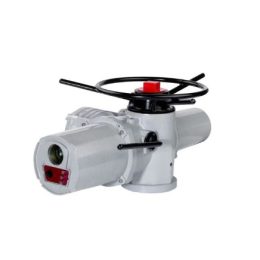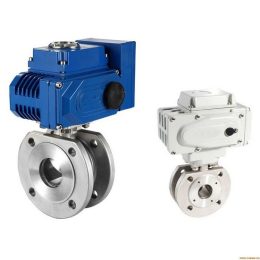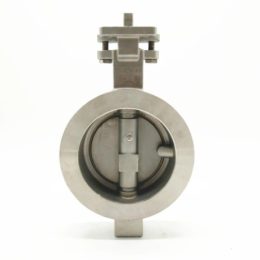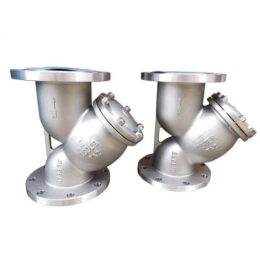Maintenance of natural gas pipeline ball valve and common troubleshooting methods
1. Daily maintenance and maintenance suggestions during operation
- Periodically check the sealing of the valve through the drain nozzle. If there is internal leakage, follow the internal leakage treatment procedure to deal with.
- Inject a certain amount of fresh grease into the valve seat in a timely manner, and the amount and frequency of injection should be in accordance with the valve It depends on the frequency of activity. Generally, after the valve is moved once, an appropriate amount of grease should be injected. Each injection is about 1/8 of the volume of the sealing system. The purpose of this is to minimize the impurities in the pipeline from entering the valve seat. The cavity affects the movement of the valve seat, resulting in sealing failure, and at the same time ensuring that the sealing surface is always in a “wet” state.
- For valves that rarely move, move them at least once a year and inject an appropriate amount of grease at the same time. This can avoid the ball and the valve seat being glued, and it can also avoid dry grinding when the ball is moving, and protect the valve seat and the ball.
- Carry out comprehensive maintenance and maintenance of the ball valve before winter, focusing on draining the water in the valve cavity and actuator to avoid freezing in winter, affecting the normal function.
- Replace the grease in the gear transmission mechanism once a year.
- Regularly check the valve diameter seal, if there is leakage, deal with it in time.
- Remove rust and maintain the exterior.
2. Maintenance and management during construction
- Correct methods should be used to load and unload the valve to avoid mechanical damage to the valve. When hoisting the valve, the hoisting strap cannot be tied to the stem or actuator for hoisting, otherwise it will cause the stem to bend, valve diameter sealing failure, and gearbox damage.
- Before leaving the factory, install simple blinds on both ends of the valve. Avoid water, sand, and other impurities entering the valve cavity during transportation and on the construction site, which will cause corrosion and damage to the seal.
- At the construction site, the valve should be placed neatly on the sleepers. Do not place it anywhere. The drain nozzle, grease nozzle, etc., are damaged or broken.
- The valve must be greased before installation. By injecting grease, on the one hand, check whether the grease injection channel is unblocked, and on the other hand, fill the seat sealing surface and rear cavity to prevent impurities from entering the sealing surface and rear cavity, and at the same time, to a certain extent, it can reduce the impact of welding high temperature on the valve seat. Damage.
- Keep the valve in the fully open position during the entire process of installation.
- After the welding is completed and the water pressure test and before and after each operation, a certain amount of grease should be added in time.
- After the water pressure test, the water in the valve cavity should be drained in time to prevent corrosion and freezing.
Common faults and troubleshooting methods
1. Ball valve internal leakage
Ball valve internal leakage is the most common problem of natural gas pipeline ball valves.
Reasons for internal leakage of ball valve
- Reasons for the internal leakage of the valve during the construction period:
- Improper transportation and hoisting caused the overall damage of the valve, which caused the internal leakage of the valve.
- When leaving the factory, the valve was not dried and anti-corrosion treated after the water pressure, resulting in the formation of rust on the sealing surface Internal leakage.
- The protection at the construction site is not in place, and there is no blind plate installed at both ends of the valve, and impurities such as rainwater and sand enter the valve seat, causing leakage.
- During installation, no grease is injected into the valve seat, causing impurities to enter the back of the valve seat or internal leakage caused by burns during welding.
- The valve is not installed in the fully open position, causing damage to the ball. During welding, if the valve is not in the fully open position, welding spatter will cause damage to the ball. When the ball is attached with welding spatter, the valve seat will be further damaged during switching, resulting in internal leakage.
- Welding slag and other construction residues will cause the sealing surface to be scratched.
- Inaccurate limit at the time of delivery or installation causes leakage, if the valve stem drive sleeve or other accessories are assembled with it, if the angle is misaligned, the valve will leak.
- Reasons for internal valve leakage during operation:
- The most common reason is that the operation manager does not maintain the valve due to relatively expensive maintenance costs, or does not perform preventive maintenance on the valve due to the lack of scientific valve management and maintenance methods. Cause the equipment to malfunction in advance.
- Improper operation or failure to follow the maintenance procedures to cause internal leakage.
- During normal operation, construction leftovers scratch the sealing surface and cause internal leakage.
- Improper pigging causes damage to the sealing surface and causes internal leakage.
- Long-term non-maintenance or inactivity of the valve will cause the valve seat and the ball to lock up, and cause the seal to damage the internal leakage when switching the valve.
- The internal leakage of the valve switch is not in place, and any ball valve generally tilts 2° regardless of the open or closed position. 3° may cause leakage.
- Many large-caliber ball valves have stem stop blocks. If they are used for a long time, rust, dust, paint will accumulate between the stem and stem stop blocks due to rust and other reasons. Other debris, these debris will cause the valve to be unable to rotate in place and cause leakage-If the valve is buried, lengthening the stem will produce and drop more rust and impurities that prevent the ball from rotating in place, causing valve leakage.
- The actuator is also limited. If it causes corrosion for a long time, the hardening of the grease or the loosening of the limit bolts will make the limit inaccurate and cause internal leakage.
- The valve position of the electric actuator is set forward, and the valve position of the electric actuator is not closed in place to cause internal leakage.
- Lack of periodic maintenance and maintenance, causing the sealing grease to dry and harden. The dried sealing grease accumulates on the elastic valve seat, hindering the movement of the valve seat and causing the seal to fail.
Judgment method of internal leakage
The fixed shaft ball valve is commonly used on natural gas pipelines. The general inspection method is: turn the valve to the fully open or fully closed position, and check whether there is any leakage through the discharge of the valve body drain nozzle. If it can be drained, the seal is good. If the pressure is always discharged, it can be considered that the valve is leaking, and the valve must be treated accordingly. But it should be particularly emphasized that for GRoVE B-5 and B-7A ball valves, PBV ball valves, and ROBERT CORT ball valves, inspections can only be performed in the fully closed position because this type of ball valve opens a passage on the valve body. When it is used to balance the pressure of the pipeline and valve cavity. But when the position is fully closed, this will not happen.
Procedure for internal leakage
- First check the valve limit to see if the internal leakage of the valve can be solved by adjusting the limit.
- Inject a certain amount of grease first to see if the leakage can be stopped. At this time, the injection speed must be slow. At the same time, observe the change of the pressure gauge pointer at the outlet of the grease gun to determine the internal leakage of the valve.
- If the leakage cannot be stopped, it is possible that the sealing grease injected early becomes hard or the sealing surface is damaged, causing internal leakage. It is recommended to inject the valve cleaning fluid at this time to clean the valve sealing surface and valve seat. Generally, soak for at least half an hour, if necessary, you can soak for several hours or even days. After the solidified material is completely dissolved, do the next step. It is best to open and close the active valve several times during this process.
- Re-inject grease, open and close the valve intermittently, and drain impurities out of the back cavity and sealing surface of the valve seat.
- Check in the fully closed position. If there is still leakage, inject reinforced sealant grease, and open the valve cavity to vent at the same time. This can generate a large pressure difference and help seal. Generally, by injecting reinforced sealant grease, the internal leakage can be eliminated.
- If there is still internal leakage, repair or replace the valve.
2. Stem leakage
The valve stem of most ball valves is equipped with upper and lower seals. Under normal circumstances, no maintenance is required. However, due to long-term wear or aging, leakage may occur at the valve stem. For valve stems with injection ports, sealing grease can be injected to temporarily stop leakage. Filling the sealing grease should be slow, preferably with a manual grease gun. When the leakage stops, the filling should be stopped. Too much filling will cause difficulty in the rotation of the valve stem. Of course, some valve stems can be sealed by injecting packing or pressing the packing gland according to the structure.
3. Abnormal operation of the ball valve
- If the ball valve is not maintained and moved for a long time, the valve seat may lock up with the ball. In this case, it is more laborious to operate the valve or even unable to operate. At this time, it is best to inject a certain amount of cleaning fluid and soak for a period of time and then operate.
- Garbage, sand, dust, or aging, hardened sealing grease in the pipeline accumulates around the seat ring and affects the seat action, causing the seat ring to jam, causing leakage between the seat and the ball. Usually, inject cleaning fluid into the valve to remove impurities.
- When the water content in natural gas is high, condensate water will appear as the environment changes during transportation. The water in the valve will have the lowest point of the valve, which is usually the lower pivot or the lower part of the valve body of the ball valve, which freezes in the lower temperature and cold conditions, causing the valve to open and close.
- When dealing with valve stem leakage, the compression screw is too tight to cause difficulty in switching, and the compression screw should not be too loose or too tight.
- For ball valves operated by worm gear and worm gear meshing transmission, there may also be the following reasons:
- The gear teeth are severely worn or broken, causing normal meshing.
- The safety pin on the worm is broken.
- The bearing on the worm or worm wheel is damaged.
- The lubrication of turbines and worms is not good. The grease used in these places is usually petroleum-based and will be contaminated by water. In cold weather, the water can freeze and make the valve inoperable. If this happens, disassemble the gearbox to remove all ice, water, and contaminated grease, and reapply new grease. If it is particularly cold, it is best to use low-temperature grease, such as alcohol-based grease.
- The bolt connecting the gearbox and the valve body is loose or cut off.
- The electric head is faulty, there is no power supply, wiring, or setting error, etc.
- There may be the following reasons for the gas-liquid linkage ball valve:
- The gas path and oil path may be blocked or the pipeline speed limit valve is closed.
- The pressure of the gas source is insufficient.
- The hydraulic cylinder or the rotating parts are sealed in a failure.
- Pressure difference The torque is too large due to other reasons.
To sum up
In order to improve the reliability of the valve and prolong the service life of the valve, it is very important to do early maintenance and supervision work, especially during the construction period and the production period. To this end, it is recommended:
- Strengthen the supervision of equipment maintenance before leaving the factory and the supervision of the transportation process.
- Strengthen the maintenance and maintenance of the equipment before installation and the supervision of the installation process.
- Before installation, be sure to conduct a hydraulic test, early Find problems and deal with them as soon as possible.
- Change concepts, carry out preventive maintenance management, formulate periodic maintenance plans and strictly implement them.
- Strengthen professional training, improve the quality of professional maintenance personnel, and achieve scientific, standardized, and safe maintenance.
- Establish and improve equipment delivery, transportation, installation, testing, maintenance, and maintenance accounts are used to record and accumulate original data for future management.
- Continue to explore and establish relevant and scientific maintenance procedures and inspection standards.



